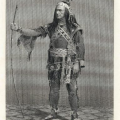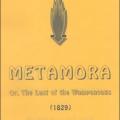“It is appalling how much we forget. Take the matter of how our towns are named, for example. Unless the history has been written down for a specific purpose at the time the naming of the town took place, chances are that 50 years later few people can give an authentic report of the circumstances surrounding the event.”
- Rev. Ralph B. Kelley (1959)
There are many stories, legends, and ideas of how this village got its name. What is the true story? What did the men of 1893 have in mind when they officially named our village METAMORA? After many hours of research, we believe we have found the answer.
Theory #1
One of the early inhabitants of this area was an old Native American who loved to tell stories. In one of his favorites, he told the story of his encounter with a man named Mowrey Potter. “ I came along the road, and met a Mowrey” In the retelling, Met – A – Mowrey, became Met-A – Mora.
OR
An old man met more than a dozen people on the road….. Met- More- ‘n- a dozen….., “Met-a –More –‘n ”…., Met-A-Mora.
Theory #2
Local Soldiers returning from the Mexican-American War brought back the name of a battle site in Mexico, the village of Metamoros.
Theory #3
The village was named in honor of a young woman, named Meta Mohr.
Meta, born in January of 1870 to Catharine and Jacob Mohr, died at the age of 23 only 3 months before the incorporation of the village. One of the signatures included on the petition for incorporation is Leonard Mohr. Meta and her parents are buried in the Dutch Ridge Cemetery.
Theory #4
The last, and we believe correct theory is a bit of a longer story. It starts with the Pilgrims way back in 1620…………
When the Pilgrims landed at Plymouth Rock in November of 1620, they were befriended and aided by a local Wampanoag tribe and their chief, MASSASOIT. The two groups maintained a good relationship with one another for many years, and gave us the First Thanksgiving. Chief Massasoit died around 1660, and was succeeded by his son Wamsutta as chief. Wamsutta died shortly after in 1662, and Metacom , the 2nd son of Massasoit, succeeded him.
Metacom was given an English name prior to his becoming chief; the colonists referred to him as “King Philip”.
Metacom took over during a time of Indian land being exchanged for English guns, ammunition, liquor, and blankets. Eventually the two groups could no longer resolve their differences, and King Philips war broke out in 1675, and Metacom “King Philip” died in the final battle, after being betrayed by one of his own.
More than 150 years later, a play was written that would resurrect the legend of Metacom. METAMORA, THE LAST OF THE WAMPANOAGS.

The play, Metamora, was written in response to a contest boasting a $500 prize for an original play. The contest was posted in the New York Critic by actor, Edward Forrest. The winner was required to write “a tragedy, in 5 acts, of which the hero,…..shall be an aboriginal of this country.” Playwright, John Augustus Stone based his principal character, Metamora, on the life and death of Chief Metacom.
Washington Irving; American short story writer, essayist, biographer, historian, and diplomat of the early 19th century, wrote of Chief Metacom-
“He was a patriot attached to his native soil, a prince true to his subjects and indignant of their wrongs, a soldier, daring in battle, firm in adversity, and ready to perish in the cause he had espoused. He was proud of heart and had an untamable love of natural liberty.”
The fictional character Metamora was depicted as 1 a tragic, noble Indian hero turned violent only by force 2 a man of straight forward honor who will risk his life to keep a promise,..
1 wikipedia.org 2 metropolitanplayhouse.org

The play Metamora, the Last of the Wampanoags opened in New York City on December 15, 1829, and was an instant hit.
“For 40 years the play ran in New York, and then for more than 17 years on the road, and everywhere it played – in opera houses, town halls and school houses – it was a smashing success.”
–Rev. Kelley
The name Metamora was officially recorded at the county seat (Ottokee at the time) in 1851, but the name was used in reference to this area in the 1840s. The village was incorporated in 1893 by the Fulton County Board of Commissioners stating……
”That the limits of the proposed corporation are accurately described and are not unreasonably large or small. That there is the requisite population for the proposed corporation, (not less than 216 residents), and that the name proposed is appropriate.”
-Original Petition for Incorporation
The organization of our village takes place during the time period of Metamora, The Last of the Wampanoags fame. Certainly, local residents were aware of this famous play, and the virtues that Metamora displayed.
While we cannot know for certain that this is where the men who named our town got their inspiration, it is a good theory based in historical facts.
The Metamora Area Historical Society has approached the Evergreen High School Performing Arts department about the possibility of a production of Metamora, the Last of the Wampanoags for our community.
Metamora came very close, within a few votes, of being called “Stumpville”.

